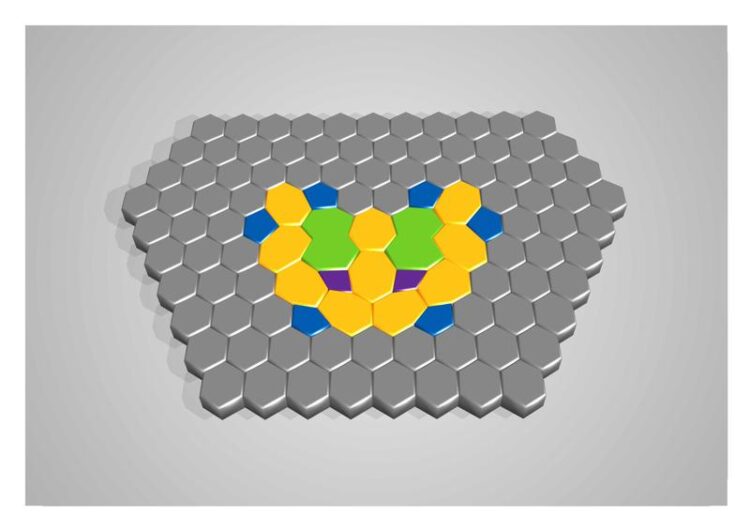MLU physicists solve mystery of two-dimensional quasicrystal formation from metal oxides

A substructure consisting of rings of different sizes embeds itself seamlessly into a hexagonal structure.
(c) Uni Halle / Stefan Förster
The structure of two-dimensional titanium oxide brakes-up at high temperatures by adding barium; instead of regular hexagons, rings of four, seven and ten atoms are created that order aperiodically.
A team at Martin Luther University Halle-Wittenberg (MLU) made this discovery in colaboration with researchers from the Max Planck Institute (MPI) for Microstructure Physics, the Université Grenoble Alpes and the National Institute of Standards and Technology (Gaithersburg, USA), thereby solving the riddle of two-dimensional quasicrystal formation from metal oxides. Their findings have been published in the renowned journal “Nature Communications”.
Hexagons are frequently found in nature. The best-known example is honeycomb, but graphene or various metal oxides, such as titanium oxide, also form this structure. “Hexagons are an ideal pattern for periodic arrangements,” explains Dr Stefan Förster, researcher inthe Surface and Interface Physics group at MLU’s Institute of Physics. “They fit together so perfectly that there are no gaps.” In 2013, this group made an astonishing discovery upon depositing an ultrathin layer containing titanium oxide and barium on a platinum substrate and heating it to around 1,000 degrees centigrade in ultra-high vacuum. The atoms arranged themselves into triangles, squares and rhombuses that group in even larger symmetrical shapes with twelve edges. A structure with 12-fold rotational symmetry was created, instead of the expected 6-fold periodicity. According to Förster, “Quasicrystals were created that have an aperiodic structure. This structure is made of basic atomic clusters that are highly ordered, even if the systematics behind this ordering is difficult for the observer to discern.” The physicists from Halle were the first worldwide to demonstrate the formation of two-dimensional quasicrystals in metal oxides.
The mechanisms underlying the formation of such quasicrystals remained puzzling since their discovery. The physicists at MLU have now solved this riddle in collaboration with researchers from the Max Planck Institute for Microstructure Physics Halle, the Université Grenoble Alpes and the National Institute of Standards and Technology (Gaithersburg, USA). Using elaborate experiments, energetic calculations and high-resolution microscopy, they have shown that high temperatures and the presence of barium create a network of titanium and oxygen rings with four, seven and ten atoms respectively. “The barium both breaks up the atomic rings and stabilises them,” explains Förster, who heads the joint project. “One barium atom is embedded in a ring of seven, two in a ring of ten.” This is possible because the barium atoms interactelectrostatically with the platinum support, but do not form a chemical bond with the titanium or oxygen atoms.
With their latest discovery the researchers have done more than just clarify a fundamental question of physics. “Now that we have a better understanding of the formation mechanisms on the atomic level, we can try to fabricate such two-dimensional quasicrystals on demand in other application-relevant materials like metal oxides or graphene,” says Förster. “We are excited to learn whether this special arrangement will produce completely new and useful properties.”
The experiments were carried out as part of the project “Aperiodic crystals: structure, dynamics and electronic properties”, which is funded by the Deutsche Forschungsgemeinschaft (DFG – German Research Foundation) and the French Agence Nationale de la Recherche.
Paper: Schenk S., Krahn O., Cockayne E., Meyerheim H. L., de Boissieu M., Förster S., Widdra W. 2D honeycomb transformation into dodecagonal quasicrystals driven by electrostatic forces. DOI.org/10.1038/s41467-022-35308-z
Originalpublikation:
DOI.org/10.1038/s41467-022-35308-z
https://pressemitteilungen.pr.uni-halle.de/index.php?modus=pmanzeige&pm_id=5525
Media Contact
All latest news from the category: Physics and Astronomy
This area deals with the fundamental laws and building blocks of nature and how they interact, the properties and the behavior of matter, and research into space and time and their structures.
innovations-report provides in-depth reports and articles on subjects such as astrophysics, laser technologies, nuclear, quantum, particle and solid-state physics, nanotechnologies, planetary research and findings (Mars, Venus) and developments related to the Hubble Telescope.
Newest articles

Innovative 3D printed scaffolds offer new hope for bone healing
Researchers at the Institute for Bioengineering of Catalonia have developed novel 3D printed PLA-CaP scaffolds that promote blood vessel formation, ensuring better healing and regeneration of bone tissue. Bone is…

The surprising role of gut infection in Alzheimer’s disease
ASU- and Banner Alzheimer’s Institute-led study implicates link between a common virus and the disease, which travels from the gut to the brain and may be a target for antiviral…

Molecular gardening: New enzymes discovered for protein modification pruning
How deubiquitinases USP53 and USP54 cleave long polyubiquitin chains and how the former is linked to liver disease in children. Deubiquitinases (DUBs) are enzymes used by cells to trim protein…


